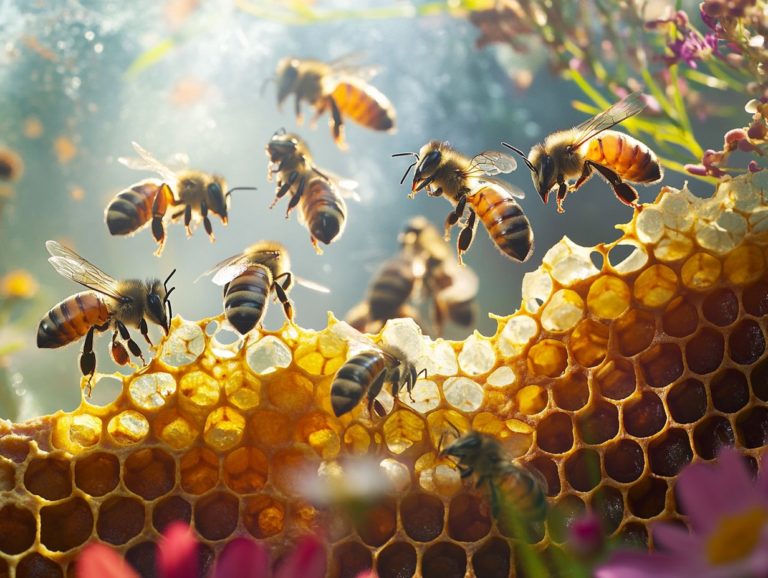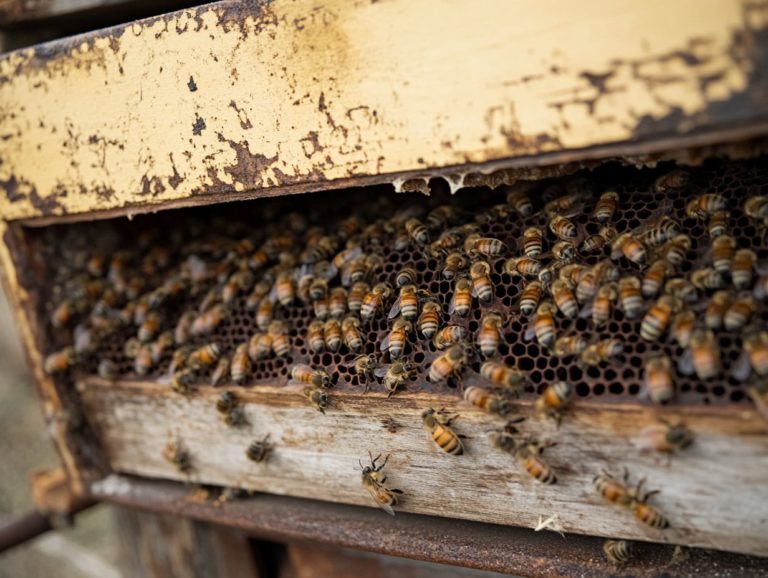The Role of Brood in Hive Management
In Beekeeping, ‘brood’ refers to the young bees at various stages of development within the hive. These young bees play a crucial role in the health and productivity of your bee colony.
Understanding the different types of brood, recognizing their health, and implementing effective management strategies is critical to your colony’s success as a beekeeper.
This article reveals why brood is vital for hive management, highlighting the signs of healthy versus unhealthy brood and offering practical tips to promote their production and overall development, ensuring a thriving hive ecosystem.
Join in as we uncover the vital role of brood in maintaining bee vitality, swarming behavior, and enhancing your beekeeping success.
Contents
- Key Takeaways:
- What is a Brood in Beekeeping?
- Why is Brood Important in Hive Management?
- How to Identify Healthy Brood?
- How to Manage Brood in a Hive?
- What is the Role of Brood in the Hive’s Ecosystem?
- Frequently Asked Questions
- What is the role of brood in hive management?
- How does brood affect the behavior of worker bees?
- Why is it important to monitor brood development in a hive?
- Wondering how brood affects a queen bee’s behavior? Let s explore!
- What factors can impact brood development in a beehive?
- What can beekeepers do to support brood development in their hives?
Key Takeaways:

- Brood is the term used to describe the eggs, larvae, and pupae of bees in a hive, covering all stages of their lifecycle.
- Brood plays a crucial role in hive management as it affects the population and health of the hive.
- Proper brood management includes identifying healthy brood, promoting brood production, and addressing common brood diseases such as American Foulbrood (a bacterial infection) and Varroa mite infestations (a parasitic threat) to maintain a thriving hive ecosystem.
What is a Brood in Beekeeping?
In Beekeeping, ‘brood’ describes the developmental stages of bees within a hive, capturing the complete journey from the queen bee laying her eggs to the maturation of the worker bees. This series of stages encompasses several life stages, starting with the egg stage, where a fertilized egg transforms into a larva, and continuing into the pupal stage, where larvae undergo their remarkable change.
Grasping the dynamics of brood development is essential for you as a beekeeper, as a healthy brood directly influences the vitality of your colony, enhances honey production, and ensures the overall well-being of your hive. This involves recognizing the life stages from eggs, larvae, to pupae within the brood chamber.
Why is Brood Important in Hive Management?
Brood management is crucial for effective hive oversight, as it significantly impacts the health and productivity of your bee colony. Observing healthy brood patterns is a strong indicator of a thriving colony, where worker bees are diligently gathering nectar and pollen, ultimately enhancing honey production.
By keeping a close eye on the brood, you can evaluate the overall vitality of your hive and make well-informed decisions, ensuring that your colony stays robust and ready to swarm when the time calls for it.
What are the Different Types of Brood in a Hive?
In a hive, you ll find three primary types of brood, each playing a unique role in the colony’s intricate ecosystem: worker brood, drone brood, and queen brood. The worker brood consists of fertilized eggs that develop into female worker bees, integral to the hive’s daily operations. On the other hand, drone brood is comprised of unfertilized eggs that become male drones, essential for reproduction.
Then there’s the queen brood, which receives special nurturing with royal jelly, allowing select larvae to develop into queen bees vital figures for reproduction and the colony’s expansion.
The worker brood is essential, as these bees will take on key responsibilities like foraging for nectar and pollen, maintaining the hive’s structure, producing beeswax for honeycomb, and caring for the young. Meanwhile, the drone brood serves a crucial purpose in reproduction, mating with queens from other hives to ensure a healthy genetic diversity.
The queen brood stands apart; selecting which larvae will become queens is a deliberate process, as these future queens are tasked with ensuring the hive’s longevity and stability.
This intricate system demonstrates the interdependence within the hive, highlighting how each brood type contributes to the colony’s health, productivity, and long-term survival.
How to Identify Healthy Brood?
Identifying healthy brood is essential for you as a beekeeper, as it serves as a key indicator of your colony’s overall well-being. When you observe a consistent pattern in the brood chamber, it reveals well-fed larvae that are plump and creamy white, signaling that your worker bees are caring for them properly.
Furthermore, the sight of eggs in the cells and the absence of disease are critical signs of a thriving hive. These factors not only impact honey production but also play a significant role in the longevity of your colony.
What are the Signs of Healthy Brood?

Signs of a healthy brood include a well-defined brood pattern, where you can see eggs, larvae, and pupae all clustered together. This shows your queen bee is hard at work, keeping the colony strong! Look for larvae that are pale and plump. Ensure the cells are properly capped when they reach the pupal stage; this reflects the attentive care provided by the worker bees.
When you observe these signs, it s a strong indication that your colony is thriving. This greatly enhances its potential for successful honey production and overall vitality.
As a beekeeper, it s vital for you to pay attention to the uniformity of the brood. Irregular patterns can signal problems with the queen or the overall health of the colony. Regular checks for signs of disease, like deformed larvae or cells that are uncapped or filled with liquid, can help you maintain a robust population.
Monitoring the hygiene of the hive is equally essential. A clean hive creates a more favorable environment for the brood to develop properly. By consistently observing these key indicators, you can foster a healthier brood and support the long-term success of your colonies.
What are the Signs of Unhealthy Brood?
Unhealthy brood can reveal itself through various warning signs that you, as a beekeeper, should be keenly aware of. Look out for irregular brood patterns, where you might notice empty cells or cells containing dead larvae. These could indicate serious issues like American Foulbrood (a bacterial disease) or Varroa mite infestations (parasitic mites that affect honey bees). Diseased larvae often appear dark or shriveled. If you catch a whiff of foul odors, that s a telltale sign of underlying problems within the hive that could jeopardize the health of your colony and its honey production.
Understanding these symptoms is vital; catch them early to protect your hive! These symptoms signal not just immediate threats but can pave the way for larger issues, such as a decline in the hive s strength and longevity.
For example, if the worker bees are struggling, their ability to forage and care for the queen diminishes significantly, affecting brood production and honey yields.
Conducting regular hive inspections will help you spot these symptoms early. This will help you take quick actions, such as isolating affected frames or administering appropriate treatments.
By prioritizing the health of the brood, you can ensure that your entire colony thrives. This keeps productivity and vitality high throughout the season, securing your honey yields.
How to Manage Brood in a Hive?
Effective brood management is crucial for maintaining a productive hive. It encompasses a range of practices designed to nurture the health and development of your bee population.
This means regularly monitoring brood patterns and health. Providing sufficient feeding with nectar and pollen fosters larvae growth, and implementing robust disease prevention strategies combats threats such as American Foulbrood and Varroa mites. Regular checks are necessary to prevent diseases that could spread through the brood box.
By prioritizing brood management in your beekeeping routine, you can significantly boost honey production and enhance the overall stability of your colonies.
What are the Factors that Affect Brood Production?
Several factors can significantly influence brood production within your hive, ultimately impacting the overall health of your colony. The availability and quality of nectar and pollen are very important; if food resources are lacking, it can hinder your queen bee’s egg-laying capacity and the development of healthy larvae.
Environmental conditions, hive space, and the tendency for swarming also play crucial roles in either limiting or enhancing brood production. This makes it essential for you to monitor these aspects closely.
Temperature and humidity levels within the hive are critical for brood rearing. Maintaining the best conditions is vital for ensuring larval viability. Adequate space is equally important, as overcrowding may trigger swarming behavior, diverting valuable resources away from brood production.
You can optimize these conditions by ensuring a steady supply of nutrients and maintaining proper hive ventilation.
By implementing practices such as routine inspections and effective hive management techniques, you will foster a conducive environment that ultimately leads to increased brood production and a thriving bee colony. Ensuring the cleanliness and functionality of the honeycomb within the brood box is also essential.
How to Promote Brood Production in a Hive?
To promote brood production in your hive, you can implement several effective strategies that support the queen bee and enhance overall hive health. Regularly providing supplemental feeding with high-quality nectar and pollen substitutes can significantly boost larvae development.
Ensure that your hive has ample space and the proper cell conditions for new brood. Maintaining optimal temperature and humidity levels will foster a conducive environment for increasing brood production.
Regularly check your hives to spot any signs of stress or disease that could hinder brood production. By employing hive management techniques such as rotation and splitting hives, you can stimulate growth and reinforce the population.
Protect your hive from harsh environmental factors like excessive wind or extreme temperatures to create a stable habitat for your honey bees. Conducting regular inspections allows you to make timely adjustments, ensuring that both the queen and her worker bees are thriving, which ultimately leads to a robust and productive brood.
What are the Common Brood Diseases and How to Treat Them?

Common brood diseases like American Foulbrood and challenges posed by Varroa mites, small parasites that can harm bee colonies, are serious threats to your bee colonies that demand your prompt attention and treatment.
These diseases not only harm individual hives but can also disrupt local ecosystems, given the vital role bees play in pollination. It s essential for you, as beekeepers, to remain vigilant and conduct regular inspections to catch early signs of infection, allowing you to take swift action to mitigate risks.
Along with utilizing chemical treatments for Varroa mites, you might consider organic alternatives, which offer a less toxic approach. Implementing preventive measures such as maintaining healthy hive conditions, ensuring your bees receive proper nutrition, and practicing good biosecurity can greatly diminish the chances of disease outbreaks.
Regularly feeding your bees with supplements can also support their health and resilience. By adopting effective management strategies, including rotating your apiary locations and minimizing stress on your colonies, you can cultivate a more resilient environment that protects your hives and fosters overall bee health.
Managing the brood chamber effectively can help maintain optimal conditions for your bees. Stay active in your hive management for a healthier bee colony!
What is the Role of Brood in the Hive’s Ecosystem?
In the intricate ecosystem of the hive, brood plays a crucial role, serving as the cornerstone for the colony’s population and functionality. Maintaining healthy brood is essential for ensuring a stable workforce of bees tasked with gathering nectar and pollen activities that are vital for honey production and the overall sustainability of the hive. The development of the brood, from eggs to larvae to pupae, is a critical process that requires careful attention from the beekeeper. Additionally, the queen bee’s ability to produce brood shapes the colony’s dynamics, affecting swarming behavior and the hive’s ability to adapt to environmental changes. The brood pattern can be an indicator of the queen’s health and the overall vitality of the colony.
How does Brood Affect the Population and Health of the Hive?
Brood directly influences the population and health of your hive by determining the number of bees available for foraging and hive maintenance. A vigorous brood population, carefully nurtured by worker bees and overseen by the queen bee, results in a thriving colony that excels in honey production and demonstrates resilience against diseases. The different life stages of the brood, from eggs to larvae to pupae, are critical for maintaining a dynamic and productive hive.
On the flip side, a decline in brood health can lead to fewer workers, ultimately jeopardizing the colony’s viability and honey yield. The connection between brood health and the overall dynamics of your hive is essential; every stage of brood development is crucial for sustaining the workforce necessary for daily operations. Healthy brood not only boosts the number of foragers but also guarantees the presence of nurse bees worker bees that care for the larvae and maintain cleanliness within the hive. Proper brood management is vital for the health of the colony, so you must manage the brood effectively by monitoring patterns and maintaining optimal conditions within the brood box.
Therefore, as a beekeeper, nurturing the brood is crucial for your hive’s success. Focus on providing the best nutrition, disease management, and optimal environmental conditions to ensure vibrant health and productivity. Grasping this relationship allows you to anticipate shifts in colony strength, enabling you to take proactive measures to maintain the vigor and longevity of your hive. The use of royal jelly in feeding the brood can also enhance their development and overall health.
What are the Benefits of Proper Brood Management for Beekeepers?
Proper brood management offers a myriad of benefits for beekeepers. It primarily boosts honey production and ensures the overall health of your hive.
By closely monitoring and managing brood conditions, you can optimize how well the queen bee lays eggs and maintain robust populations of worker bees. This proactive approach strengthens the colony against diseases and swarming, paving the way for more sustainable beekeeping practices.
Optimal brood management significantly enhances your colony’s resilience, allowing it to adapt to varying environmental stresses and resource availability. When you adopt best practices, such as regular inspections and thoughtful brood placement, you fortify the overall vigor of your hive.
This results in healthier bees with superior foraging abilities. Not only does this boost productivity in the short term, but it also ensures a stable population over time, minimizing the need for frequent re-queening, which is changing the queen bee when necessary.
Maintaining the health of the brood box and ensuring a consistent supply of beeswax for honeycomb construction are essential aspects of successful brood management. When you embrace these strategies, you’ll feel the thrill of success and satisfaction in your beekeeping journey!
Frequently Asked Questions
What is the role of brood in hive management?

The brood, or young bees, play a critical role in the overall health and productivity of a beehive. They are responsible for replenishing the colony’s population and producing the next generation of worker bees.
The stages of brood development, from eggs to larvae to pupae, are integral to the lifecycle of the hive.
How does brood affect the behavior of worker bees?
The presence of brood in the hive triggers specific behaviors in worker bees, such as increased foraging and food storage activities. They need to provide for the growing brood and ensure the survival of the colony.
Feeding the brood with royal jelly and maintaining the brood cells are essential tasks performed by worker bees.
Why is it important to monitor brood development in a hive?
You must monitor brood development because it reveals the hive’s health! A healthy brood population indicates a strong and productive hive, while issues with brood development can signal potential problems.
Regularly inspecting the brood pattern and ensuring proper conditions within the brood box can help identify and address issues early on.
Wondering how brood affects a queen bee’s behavior? Let s explore!
The presence of brood in the hive affects the queen bee’s behavior. She is responsible for laying eggs and keeping a healthy brood. A strong brood can influence the queen’s pheromone production, which helps regulate the behavior of other bees in the colony.
The queen’s egg-laying efficiency is crucial for sustaining a robust brood pattern and overall hive health.
What factors can impact brood development in a beehive?
Several factors can affect brood development, including temperature, food availability, and pest infestations. These factors impact the health and survival of the brood and the overall health of the hive.
Ensuring proper feeding with royal jelly a nutrient-rich substance secreted by worker bees is essential for optimal brood development.
What can beekeepers do to support brood development in their hives?
Beekeepers can support brood development by ensuring the hive has enough food and resources. Maintaining proper temperature and ventilation, along with monitoring for pests or diseases, is also important.
Don t forget! Regular hive inspections and smart management practices are key to a thriving brood! Act promptly against American Foulbrood and Varroa mites to keep your brood healthy!
Managing the brood chamber effectively and ensuring a consistent supply of beeswax for honeycomb construction are also important.






